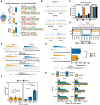Directed Evolution of an Enhanced POU Reprogramming Factor for Cell Fate Engineering
- PMID: 33720298
- PMCID: PMC8233511
- DOI: 10.1093/molbev/msab075
Directed Evolution of an Enhanced POU Reprogramming Factor for Cell Fate Engineering
Abstract
Transcription factor-driven cell fate engineering in pluripotency induction, transdifferentiation, and forward reprogramming requires efficiency, speed, and maturity for widespread adoption and clinical translation. Here, we used Oct4, Sox2, Klf4, and c-Myc driven pluripotency reprogramming to evaluate methods for enhancing and tailoring cell fate transitions, through directed evolution with iterative screening of pooled mutant libraries and phenotypic selection. We identified an artificially evolved and enhanced POU factor (ePOU) that substantially outperforms wild-type Oct4 in terms of reprogramming speed and efficiency. In contrast to Oct4, not only can ePOU induce pluripotency with Sox2 alone, but it can also do so in the absence of Sox2 in a three-factor ePOU/Klf4/c-Myc cocktail. Biochemical assays combined with genome-wide analyses showed that ePOU possesses a new preference to dimerize on palindromic DNA elements. Yet, the moderate capacity of Oct4 to function as a pioneer factor, its preference to bind octamer DNA and its capability to dimerize with Sox2 and Sox17 proteins remain unchanged in ePOU. Compared with Oct4, ePOU is thermodynamically stabilized and persists longer in reprogramming cells. In consequence, ePOU: 1) differentially activates several genes hitherto not implicated in reprogramming, 2) reveals an unappreciated role of thyrotropin-releasing hormone signaling, and 3) binds a distinct class of retrotransposons. Collectively, these features enable ePOU to accelerate the establishment of the pluripotency network. This demonstrates that the phenotypic selection of novel factor variants from mammalian cells with desired properties is key to advancing cell fate conversions with artificially evolved biomolecules.
Keywords: POU; cell fate conversion; molecular evolution; protein engineering; reprogramming; transcription factor.
© The Author(s) 2021. Published by Oxford University Press on behalf of the Society for Molecular Biology and Evolution.
Figures






Similar articles
-
Changing POU dimerization preferences converts Oct6 into a pluripotency inducer.EMBO Rep. 2017 Feb;18(2):319-333. doi: 10.15252/embr.201642958. Epub 2016 Dec 22. EMBO Rep. 2017. PMID: 28007765 Free PMC article.
-
Sox2 and Klf4 as the Functional Core in Pluripotency Induction without Exogenous Oct4.Cell Rep. 2019 Nov 12;29(7):1986-2000.e8. doi: 10.1016/j.celrep.2019.10.026. Cell Rep. 2019. PMID: 31722212
-
Directed Evolution of Reprogramming Factors by Cell Selection and Sequencing.Stem Cell Reports. 2018 Aug 14;11(2):593-606. doi: 10.1016/j.stemcr.2018.07.002. Epub 2018 Aug 2. Stem Cell Reports. 2018. PMID: 30078555 Free PMC article.
-
Diversity among POU transcription factors in chromatin recognition and cell fate reprogramming.Cell Mol Life Sci. 2018 May;75(9):1587-1612. doi: 10.1007/s00018-018-2748-5. Epub 2018 Jan 15. Cell Mol Life Sci. 2018. PMID: 29335749 Free PMC article. Review.
-
What makes a pluripotency reprogramming factor?Curr Mol Med. 2013 Jun;13(5):806-14. doi: 10.2174/1566524011313050011. Curr Mol Med. 2013. PMID: 23642061 Review.
Cited by
-
Evaluation of the determinants for improved pluripotency induction and maintenance by engineered SOX17.Nucleic Acids Res. 2023 Sep 22;51(17):8934-8956. doi: 10.1093/nar/gkad597. Nucleic Acids Res. 2023. PMID: 37607832 Free PMC article.
-
The homeodomain of Oct4 is a dimeric binder of methylated CpG elements.Nucleic Acids Res. 2023 Feb 22;51(3):1120-1138. doi: 10.1093/nar/gkac1262. Nucleic Acids Res. 2023. PMID: 36631980 Free PMC article.
-
The functional diversity of the POUV-class proteins across vertebrates.Open Biol. 2022 Jun;12(6):220065. doi: 10.1098/rsob.220065. Epub 2022 Jun 29. Open Biol. 2022. PMID: 35765816 Free PMC article. Review.
-
Programming human cell fate: overcoming challenges and unlocking potential through technological breakthroughs.Development. 2023 Dec 15;150(24):dev202300. doi: 10.1242/dev.202300. Epub 2023 Dec 11. Development. 2023. PMID: 38078653 Free PMC article.
-
Lineage Reprogramming: Genetic, Chemical, and Physical Cues for Cell Fate Conversion with a Focus on Neuronal Direct Reprogramming and Pluripotency Reprogramming.Cells. 2024 Apr 19;13(8):707. doi: 10.3390/cells13080707. Cells. 2024. PMID: 38667322 Free PMC article. Review.
References
-
- Aksoy I, Jauch R, Eras V, Chng WB, Chen J, Divakar U, Ng CK, Kolatkar PR, Stanton LW.. 2013. Sox transcription factors require selective interactions with oct4 and specific transactivation functions to mediate reprogramming. Stem Cells 31(12):2632–2646. - PubMed
-
- Asial I, Cheng YX, Engman H, Dollhopf M, Wu B, Nordlund P, Cornvik T.. 2013. Engineering protein thermostability using a generic activity-independent biophysical screen inside the cell. Nat Commun. 4:2901. - PubMed
Publication types
MeSH terms
Substances
LinkOut - more resources
Full Text Sources
Other Literature Sources
Molecular Biology Databases
Research Materials

